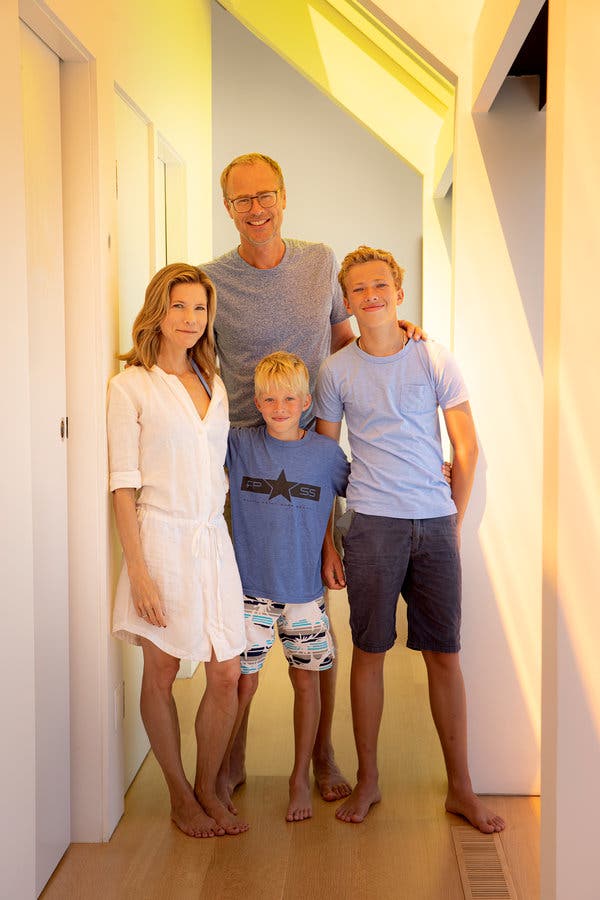When Nina Edwards Anker was growing up, her family spent summers and weekends in a shingled cottage in Southampton, N.Y.
An expansion of a carriage house originally designed in 1890 by Stanford White, it belonged to a genre typical of the Hamptons. But the version that Ms. Anker — the 48-year-old founder of the Brooklyn design company Nea studio — designed for herself; her husband, Peder Anker, a history of science professor at New York University; and their two sons is anything but common. Located on the same property as her childhood cottage (which her brother now occupies), Cocoon House is a LEED-certified example of sustainable design that strays from many of the local norms.

For one thing, there’s its size: at 1,730 square feet, Cocoon House, which is named for its rounded, sheltering cedar-shingled walls, is smaller than some Hamptons pool houses, and it has no second story, wraparound porch or dormer windows. But small is beautiful when you’re aiming for energy efficiency.
In addition to running her studio, Ms. Anker is the design director of Terreform ONE, an eco-focused architectural think tank that designed an urban habitat for at-risk monarch butterflies now on display at the Cooper Hewitt Triennial. “I realized that we have no choice but to engage with the crisis happening around us,” she said. Cocoon House proves that sustainable design doesn’t preclude gracious proportions, generous daylight or elegant interiors.
You enter on the shingled north side, into a living-dining-kitchen space with curved white walls and ceilings that facilitate air circulation and soften sound. (The 16-foot-high interiors give even the smallest rooms, like the sons’ bedrooms, a lofty feeling.) The furnishings are a mixture of CB2 and Ms. Anker’s own creations — including an origami-like wicker settee and matching chairs, and a sofa whose cushion is filled with dried lentils.
In the living and dining areas, chandeliers designed by Ms. Anker combine small photovoltaic panels with discs or squares of seashell, and turn on automatically at dusk. She also created the chandelier in the master bedroom with molded-algae shades.
The house is actually L-shaped. On the north and west sides, its rounded, thick and heavily insulated walls retain heat and provide privacy, while on the south and east sides, 65 feet of continuous sliding glass doors, topped by skylights, admit ocean breezes and provide views to the water and trees. Through the south-facing glass, the sun warms the house in winter, while interior shades and curtains reduce the heat gain in summer by half.
The house, Ms. Anker, said, is “half closed and half open, half curved and half crystalline.” Environmental regulations required it to be located at a 150-foot radius from nearby wetlands, and the house (which has a crawl space, but no basement) is raised a couple of feet above the wet zone. Its structure is made entirely of timber, which has a smaller carbon footprint than steel.
A combination cistern-reflecting pool wraps around the east and south sides, projecting sunlight into the interior during the day and creating a mirror effect at dusk, while it also scores LEED points by cooling the air and irrigating the surrounding lawn. Glass panels in the skylights, with tints were inspired by Goethe’s theories on color, are red and orange in the master bedroom (to promote rest), and yellow in the living area (to encourage activity). A triangular skylight in the master bedroom “is like a solar clock,” Ms. Anker said, tracing the sun’s path along the room’s white walls.
Everything in the design is geared toward maximum efficiency. Closed-cell foam insulation in the shingled walls combats the humidity that creates a moldy smell in many beach houses, and the doors and windows are passive-house certified. The energy-recovery ventilation system — “You have to ventilate from the outside, not just the inside,” Ms. Anker emphasized — runs on electricity, using no oil or gas, and heating is necessary only on winter nights, or on days that are cold and cloudy. (The fireplace is also energy efficient.) Photovoltaic panels on the nearby garage generate more electricity than the house needs from April through October.
Ms. Anker said the building’s size and shape — it has far fewer corners than most houses — cut about 15 to 20 percent on materials and costs. Prefabricated trusses saved construction time (and therefore expense), and computer modeling controlled the shaping of materials, reducing waste.
When asked what she likes best about living there, she described the different ways the sun enters with each season. The house, she said, “is like a cinema for moving shadows.”







